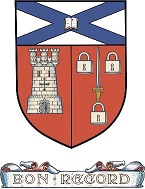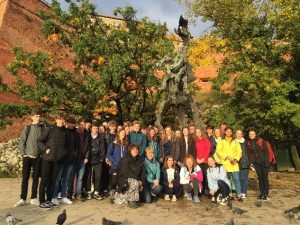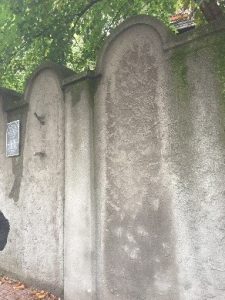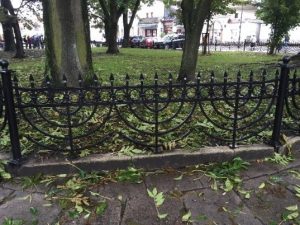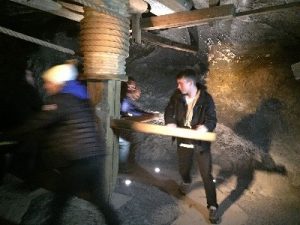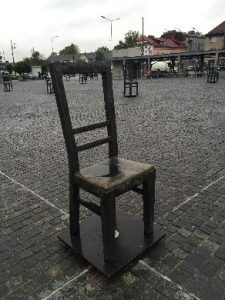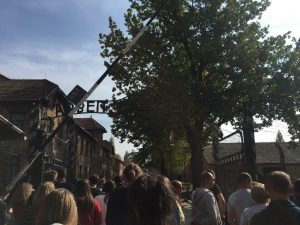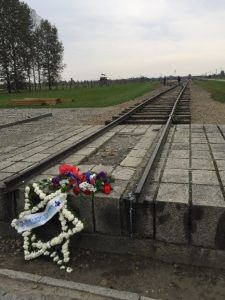We visited Auschwitz the same day we arrived in Poland; honestly, it wasn’t anything we expected. As soon as we walked through the famous black gates with those infamous words “Arbeit macht frei”, or Work Sets You Free, the atmosphere changed completely. Despite the number of tourists there, it felt as if we were walking through a ghost town. We were all taken aback; we had never experienced an environment like it. We were literally standing in the same place were millions of others had stood less than a century ago, but we were lucky: we were allowed to leave.
We were guided along the paths of the camp, on every side there were those tall red brick buildings with prison-like windows. The buildings were long and rectangular and tall barbed wire fences- which we learned would have been alive with electricity in order to keep the prisoners from escaping- kept all the buildings together like a huge outdoor prison cell. The buildings inside had been rebuilt in order to display the horrors which the Jews had had to suffer in their final days. Literally tonnes and tonnes of hair which had been shaved off the prisoners was piled up along the length of one of the rooms, gone grey over the years. In another room were empty gas canisters heaped together in a pile, only a tiny percentage of what the Nazis used to murder their prisoners. Pictures of the prisoners arriving with their suitcases full of personal belongings, and maps to show the extent to which the Nazis went about systematically killing Jews and other prisoners were hung up on the walls to give us some understanding of what the Jews had gone through.
I think one of the displays the whole group found the most upsetting was the small drawings on the white walls of an empty room; an artist had recreated what had been drawn by Jewish children while they were in Auschwitz, really bringing home the fact that these people were human, many of them younger than us, and not some old statistic from a history book. It reflected, along with the suitcases, the small sense of hope that the Jews must have had. The realisation of the fact that these people had been no different from ourselves made the situation of it all a lot harder to think of and believe, despite the fact that we were there. How could people do such a thing to other people?
The small stone chambers where many prisoners had been kept in had wooden slats for windows and nowhere for them to sleep or sit down. We descended down to these prison cells with their cold stone walls and iron bars; there were no toilets and no way of keeping clean. We learned that prisoners could be kept down there for weeks, and many suffocated. There were very small cells where a single prisoner had had to stand upright in for weeks, and slightly larger ones were dozens of prisoners had been crammed in together before they were killed either by hanging or getting shot.
After our visit to Auschwitz we got on the bus and travelled 3km to Birkenhau. On the approach to the site we were met by the familiar sight of the watch tower looming over the train tracks. As we climbed to the top of the tower the full extent of the camp dawned on us; brick and wooden barracks stretched into the distance in every direction including the latrine, sanitary quarter and gas chambers. We were especially shocked by the state of “Block 25” which the female prisoners were kept in before they were gassed. Jews and other prisoners were embarrassed to be shaven, stripper naked and made to run in front of SS officers. We followed the railway track to the end, the same path the campmates would have taken on their way to the gas chambers. Most of the gas chambers had been destroyed by the Nazis shorty before the liberation of the camp in 1945, what remains is mostly rubble.
At the end we went to a room with photographs of the Jewish families before they were imprisoned along with stories about them. After looking around, we were given a poppy as a symbol of remembrance and on leaving the camp we placed them on something that had impacted us.
I think what hit most of us the hardest that day was that it wasn’t just one man who had done all this, but hundreds. It was impossible for us to even contemplate the horrors millions of completely innocent people had had to go through, and almost even harder to imagine the heartless thought process of those who inflicted it. The visit to Auschwitz and Birkenau really has changed the way many of us look at the world and we all believe it is important that people realise that what happened in the camps isn’t just something of the past that can be forgotten about and that the people who were murdered are just a bunch of numbers and statistics, but something that should be remembered forever, and people whose faces and names should always be on our minds; so that humanity never makes the same mistake again.
On our second day we went to Kazimierz, the Jewish Quarter. This is where all the Jews lived for many years before the Holocaust; their symbols and culture are still visible. The square contained many Synagogues, book shops, restaurants and museums as well as homes and tour companies operating offering bike tours. The atmosphere there was totally different to how it would have been during the Holocaust.
After spending the morning at Kazimierz, the Jewish Quarter of Krakow, we made the short walk across the river to the Krakow ghetto as thousands of Jews would have done previous to us. In the ghetto square, the first thing that became clear to us was the considerable number of steel chairs located around us. It was intriguing and stunning to realise that each chair represented 1,000 deaths. The sheer height of the ghetto wall made it easy to comprehend how hard life was for the Jews who were trapped there. However, it was near impossible to describe how they would have felt. The lack of food, the overcrowding or the fear of the concentration camp, who could say which was worse? Although our trip to the ghetto was distressing, it was also very informative and helped us to understanding then many way the Nazis controlled the Jews of Krakow.
The Wieliczka Salt Mine we visited on the second afternoon was a very fun and interesting day. The salt mine reaches a depth of 327 metres and is 287 kilometres long. We walked 378 steps underground to reach the salt mine. We thought it was never going to end!
On our last day we spent the morning meeting a Holocaust survivor, Rena Stern. This meeting took place in the Galicia Museum which is home to many startling images from the Holocaust. Rena was born in the Ghetto and her and her mother managed to escape when she was only young. They escaped through the sewers with a group of other people and when the group went one way, her mother decided not to join them as she thought Rena, would give them away at her age. Unfortunately that group was killed by the Nazis. Rena Stern was later given to another family who agreed to look after her. Years later when her mother came to take her back, she didn’t want to go as she didn’t know that was her mother. When her mother convinced her, she left and met her father. Rena’s father was a Schindler Jew who had gone to Brinnlitz when Schindler saved his Jewish workers from being sent to Auchswitz. Although Rena is fluent Polish, our translator did an excellent job of conveying her feelings across. Rena went on to live an extraordinary life and told us many of her stories, it was humbling for us to meet her.
We later had time to explore the medieval part of Krakow. We had time to shop and try some Polish cuisine before entering the grand medieval castle to explore. We had our final group photo taken with the statue of the legendary dragon Smok.
Our final evening started with a game of bowling and a birthday celebration. As with the previous evenings we spent an hour discussing our thoughts and feelings on what we had learned that day. This was our opportunity to write down our initial emotions and discuss the relevance of issues today.
It has now more than 71 years since Auschwitz-Birkenau was liberated and as first hand memories of the Holocaust are lost forever, it is more important than ever to understand, to as large an extent as we can, why the Holocaust happened and appreciate the magnitude of tragedy caused by the unfathomable hatred of the Nazis. In our modern society it is easy to assume that the Holocaust is only history and we can afford to forget about it but the reality is wide scale ethnic hatred is both in our past and present. Even in Great Britain, a country among the most morally and socially developed in the world, more than five hundred racist incidents occurred in the first few weeks after Brexit. Due to the Syria crisis, thirteen and a half million Syrians have had their lives devastated. These events are our Holocausts and now it is up to us to make a difference.
With thanks to
Zahra Abdul
Jonathan Bell
Holly Imperiale
Clara Oxley,
Laurel Renton
Fraser Waddell
Kirstin Wilson
